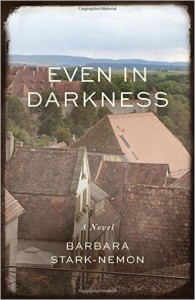When to Keep Secrets and When to Tell Truths
 Good fiction starts with a good story. Good historical fiction adds a well researched and articulated sense of time and place. Good historical fiction based on a well-documented era in one’s own family provides an author the rare opportunity to bring a loved one’s legacy to the future. Writing my recently released novel, Even in Darkness, gave me this welcome opportunity. However, in researching the book and writing other pieces based on my family’s experiences in WWII, I had to consider some important questions that I’d suggest anyone think about before writing a legacy story about a real family, especially if it is written as fiction.
Good fiction starts with a good story. Good historical fiction adds a well researched and articulated sense of time and place. Good historical fiction based on a well-documented era in one’s own family provides an author the rare opportunity to bring a loved one’s legacy to the future. Writing my recently released novel, Even in Darkness, gave me this welcome opportunity. However, in researching the book and writing other pieces based on my family’s experiences in WWII, I had to consider some important questions that I’d suggest anyone think about before writing a legacy story about a real family, especially if it is written as fiction.
Even in Darkness is based on the life of my great aunt Kläre, my grandfather’s sister, who was born in 1895, and lived her 100 years in Germany through the whole of the 20th century. I loved Kläre from the moment I met her, and as I got older, her life in Germany seemed like a mystery. Why did she stay there as a Jewish woman after surviving WWII and time in a concentration camp, when the rest of her family was in the U.S., Belgium and England? Why was she living with a Catholic priest?
Because the book is largely based on my family’s real experiences, I had to consider questions that an author might bypass if writing a purely fictional work.
- What is the story? What is the singular event or situation that grabs you and won’t let go? It has changed the way you look at things.
- Whose story is it? First, who is the central character or characters? And second, whose story is it to tell?
- What’s in the shoebox? Three months after my great-aunt Kläre died at 100, I received several large shoeboxes in the mail. I had inherited all her personal papers, including hundreds of letters and documents written by, to and about my family members in the years surrounding WWII in Germany, Palestine, England, Belgium and the U.S. If you’re writing about family, what information do you already have? What documents, people to interview, and places to visit do you already know about? And of course what else do you need to know?
- What stays in your story and what stays out? If there are family secrets, will you reveal them? What information that may fascinate you should you leave out for the sake of maintaining focus and a tight plot or out of respect for a family member?
- What will it mean to you and to others? What did you learn from telling the story? Do you understand what, beyond your personal responses, will be of value to an audience? It meant a great deal to me to bring Kläre’s story of love, courage and resilience to the page, because it inspired me at a difficult point in my life, but I also believed her story had broad appeal to others and literary merit as a novel.
- Who is going to care about this story getting into the world? Whose feelings and reputation and legacy will be affected by this story being published or shared? What work do you need to do to protect those people and yourself? What editing or disguising of people and events needs to happen?
Answering the last three questions can place an author in delicate territory.
 While bringing Even in Darkness to publication, I touched base with members of my immediate and extended family both to gather research, and to garner support for the project. I disguised identities of living people who are characters in the book. I sent samples chapters to gauge the response of people with a stake in the book’s public scrutiny.
While bringing Even in Darkness to publication, I touched base with members of my immediate and extended family both to gather research, and to garner support for the project. I disguised identities of living people who are characters in the book. I sent samples chapters to gauge the response of people with a stake in the book’s public scrutiny.
In publishing an article about a family member’s history as a spy in WWII (that was unrelated to Even in Darkness), I learned how deeply tied we are to our loved ones’ stories and how carefully a writer must gauge the feeling of ownership that attends a loved one’s legacy story. To honor a cousin’s feelings about the story I had written, I included her in the authorship of the article, and made several changes to the content. Negotiating a compromise that worked for all concerned was both challenging but also very instructive as I approached other family-based stories.
The whole truth is not necessarily what a family member wishes to see in print. Rather, the parts of a family story that sustain a descendant’s desired view of the person in question may powerfully influence that member’s sense of the “real” story. In dramatic times like the 20th century in Europe, loyalties, relationship boundaries, and social mores were violated and crossed under terrible duress, and an author must take great care to neither presume the state of a “real” character’s mind, nor rush to judgment in recreating stories of those who lived through such times.
On the other hand, there are plots to work out, story arcs that must compel readers and the “truth” that underlies the author’s passion for the story. Disguising identities, changing or omitting particularly painful truths for the sake of remaining family members, but most importantly, communicating about the work to be published to those who will be affected by the work becoming public are important ways to avoid conflict around a work based on a real family.
A writer’s passion for a good story underlies the best books. Care and consideration for those invested in the published outcome are worth any author’s time and effort.
—
Find out more about Barbara on her website http://www.barbarastarknemon.com/
Follow her on twitter @bstarknemon
Buy her novel HERE
Category: How To and Tips























